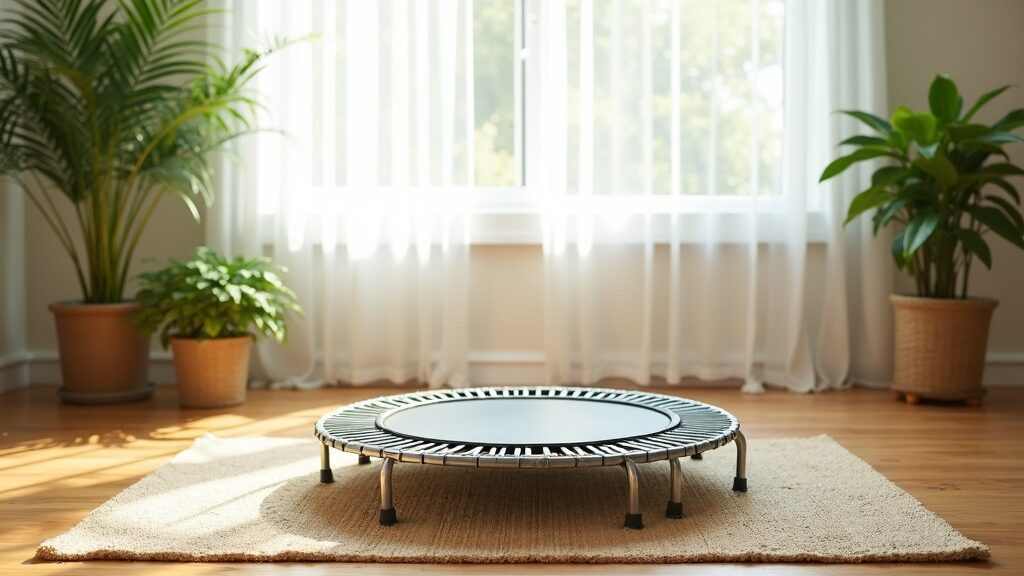Rebounding is a type of exercise that involves jumping or bouncing on a minitrampoline, commonly known as a rebounder. This simple fitness tool has become pretty popular for its ability to deliver a great workout without the impact you might get from hard running or other activities. Whether you’re looking for a fun way to move, want to spice up your fitness routine, or you’re just curious about those odd little trampolines at the gym, there’s a lot to track down about rebounding benefits.
Table of Contents
- What Makes Rebounding Unique?
- Major Health Benefits of Rebounding
- How Rebounding Supports the Lymphatic System
- Rebounding Benefits for Women
- What Men Can Gain from Rebounding
- Why Seniors Like Rebounding
- Recommended Product
- Fun Facts About Rebounding
- Tips for Getting Started with Rebounding
- Summary
- Key Takeaways
- Final Thoughts
Note: This article contains affiliate products. We earn a commission if you make a purchase, at no additional cost to you.
What Makes Rebounding Unique?
Rebounding stands out mainly because it’s super low impact on the joints but still gives you a strong cardio workout. Every time you jump, the rebounder absorbs a lot of the shock that would usually hit your knees, hips, and back. Instead, the energy is spread out, which is way easier on your body.
Aside from the comfort, the fact that you’re using gravity and weightlessness in quick bursts means your muscles, bones, and even your organs get engaged in ways traditional workouts don’t always manage. The unique support of the minitrampoline lets you move freely while reducing pressure on sensitive joints. Additionally, this friendly format often helps people begin working out after an injury or surgery, or pick up where they left off after a long break.
Major Health Benefits of Rebounding
Bouncing may look playful, but it’s actually packed with physical perks. Here are some of the things I think stand out most:
- Cardiovascular Fitness: Regular rebounding can help raise your heart rate, improve circulation, and build up stamina. It’s an effective way to get your heart pumping without running or cycling.
- Strengthens Muscles: Every bounce works your legs, glutes, core, and even some upper body muscles if you use weights or change up your routine. Over time, you build just as much tone as you would with squats or lunges.
- Improves Balance and Coordination: The unstable surface forces your stabilizer muscles to work harder, which helps with overall balance, agility, and coordination. That may even spill over into better performance with other exercises or sports.
- Bone Density Boost: The repetitive, gentle impact can encourage bone growth and might help ward off osteoporosis over the long run. Research backs up that even light jumping is good for your bones.
- Calorie Burning: A solid session on the rebounder can torch a surprising number of calories. Sometimes, you’ll burn more per minute than jogging because your whole body is working at once.
- Joint Friendly: The soft surface means your joints aren’t taking a beating. That’s one reason a lot of people with knee or hip trouble use rebounders for low impact movement. You might even notice less post-workout soreness than with running or jumping rope.
- Mental Wellbeing: Bouncing gets your endorphins flowing, which can help ease stress or even fight off a low mood. There’s something about bouncing that just feels kind of joyful. For many, putting on music or bouncing with friends also adds a social boost that helps keep motivation high.
- Support for Flexibility: Gentle stretching exercises on the rebounder can step up your flexibility, as your body warms up quickly and the soft surface encourages a full range of motion with less discomfort.
How Rebounding Supports the Lymphatic System
The lymphatic system is like your body’s internal cleaning crew; it moves lymph fluid around, helping flush out toxins, waste, and other unwanted stuff. Unlike the heart, the lymphatic system doesn’t have its own pump and relies on muscle activity and body movement to keep things moving.
When you bounce on a rebounder, every up and down motion helps move lymph fluid through your body, almost like a manual pump. Over time, this kind of stimulation is super useful for boosting detoxification, fighting swelling (edema), and keeping your immune system working its best. There’s a whole world of wellness folks who swear by rebounding for “getting things moving” when they’re feeling sluggish or under the weather. Lymph movement can affect energy levels and recovery as well, making rebounding an appealing choice for those wanting to give their body a natural boost.

Rebounding Benefits for Women
Women often look for fitness routines that are gentle on the joints, help with bone health, and target stubborn areas like hips, thighs, or lower abs. Rebounding ticks all these boxes. Regularly jumping on a rebounder can support bone strength, which is really important for women, especially after menopause when bone loss can speed up.
Also, rebounding’s ability to boost pelvic floor strength and core stability is a big deal. The gentle motion activates deep core muscles without risky high impact moves, making it a good option during and after pregnancy (with a doctor’s signoff, of course).
Plus, busy schedules mean convenience is key. You can rebound at home, in short bursts, and even include the kids or friends to make it more social. Groups of women sometimes create small fitness clubs around this activity for added accountability and fun. If you’re a mom, it’s a breeze to sneak in a quick session while the kids play nearby, making exercise feel less like a chore and more like a pleasant habit.
What Men Can Gain from Rebounding
For guys, rebounding offers a way to stay fit while mixing up the routine. It delivers a potent cardio boost, helps maintain or grow muscle tone, and supports balance (which is easy to neglect in gym routines). Because it challenges stabilizer muscles and can be amped up by holding hand weights or adding high knees, it’s great cross training for sports or weightlifting. There’s also evidence that rebounding supports testosterone production by lowering stress, which is important for general health.
Rebounding may not be the first thing most men consider, but professional athletes and trainers have started working it into strength and stamina routines for athletes in basketball, football, and martial arts. For example, football players use it for agility drills, and martial artists often use short, explosive bounce sets for footwork training. Rebounding can also help men avoid burnout from repetitive or heavy workouts by offering a low-pressure, enjoyable alternative.
Why Seniors Like Rebounding
Bouncing may not sound like a go to senior activity, but that minitrampoline is actually pretty useful as we get older. The gentle impact lowers injury risk while still helping improve balance, leg strength, and cardio capacity. Since falls are one of the top concerns for seniors, anything that builds stability is worth checking out.
Rebounders often come with support bars, so there’s extra confidence with every bounce. Even slow stepping or gentle rocking can deliver good results for those who don’t want to do jumps. Many physical therapists recommend rebounding for older adults as a fun way to work on coordination and reflexes. Plus, the ability to choose your intensity and rest as needed makes it ideal for all fitness levels. Some communities even host senior-friendly rebounder classes, turning a solo workout into a social highlight.
Recommended Product
Kanchimi Folding Mini Fitness Indoor Exercise Workout Rebounder

Fun Facts About Rebounding
- The concept was first made famous by NASA; astronauts used minitrampolines to regain bone density and muscle strength when they got back from space.
- A twenty minute session on the rebounder can offer a similar cardio effect as running, with a fraction of the impact.
- Rebounding is sometimes used in physical therapy for sports injuries and after knee or ankle surgeries.
- The lymph flow produced by rebounding can increase two to three times after just a few minutes of bouncing, according to some studies.
- Some fitness instructors have created dance or kickboxing classes uniquely designed for the rebounder, making it a next level cool way to shape up and have fun.
Tips for Getting Started with Rebounding
- Choose the Right Rebounder: Not all minitrampolines are the same. Look for solid construction, a nonslip surface, and (if you want it) a balance bar.
- Start Small: Don’t aim for high jumps right away. Gentle bounces are just as effective for most benefits. Just marching in place for a few minutes works, too.
- Mix It Up: Add some arm movements or light dumbbells, or try balancing on one leg to target different muscles.
- Listen to Your Body: If anything feels off, pause and check your form. Safety always comes before pushing too hard.
- Create a Playlist: Music can make your session fly by and help you stay motivated. Upbeat tunes can add extra fun to your bounce.
Summary
Rebounding is an easy way to sneak in some fun while looking after your heart, bones, and mental wellbeing. The low impact surface means almost anyone, from busy parents to older adults, can use it regularly. Both women and men benefit in specific ways, getting bone support, fat burning, muscle toning, and a pretty sizable perk for the lymphatic system. It’s a fitness option that works for all ages and fitness levels. Additionally, as more people mix in rebounding as part of their everyday routine, they often report better posture, deeper sleep, and an increase in overall enthusiasm for movement.
Key Takeaways
- Rebounding is low impact, high reward exercise that’s easy on your joints.
- Bouncing helps boost the lymphatic system, promoting detox and immune health.
- Both women and men can get core, balance, cardio, and bone benefits from this simple workout.
- Seniors often enjoy rebounding for improving stability and reducing fall risk.
- It’s a good option for anyone looking to add fun and efficiency to their workouts or just sneak in some movement at home.
- Rebounding is flexible and fits into short routines, making fitness accessible no matter how busy you are.
Final Thoughts
Adding rebounding to your routine doesn’t need to be complicated or expensive. I’ve seen people of all ages use rebounders for everything from full on sweaty workouts to gentle warmups or cooldown sessions. Even if you just spend five minutes a day bouncing while watching TV, you’ll likely start to notice the difference. Overall, rebounding offers a low pressure, enjoyable way to stay active and look after your health. If you’re hunting for something new to add to your exercise repertoire, grabbing a rebounder might just give your fitness routine the boost you’ve been after. Happy bouncing!



